Organizational Behavior Assignment: Leadership and Motivation
VerifiedAdded on 2022/10/17
|8
|1921
|18
Homework Assignment
AI Summary
This assignment explores various aspects of organizational behavior, including leadership theories, motivation strategies, and the impact of innovation. The student analyzes the differences between trait and behavior theories of leadership, discusses how organizations can develop effective leaders, and identifies sustaining and disruptive innovations. The assignment also examines group behavior, teamwork, and the influence of workplace culture, referencing specific case studies and providing examples. Furthermore, it addresses the importance of cultural aspects in maintaining a positive and productive work environment, highlighting key elements such as HRM practices, leadership styles, and conflict management. The student integrates diverse OB theories and practices, providing critical analysis and clear communication of ideas.
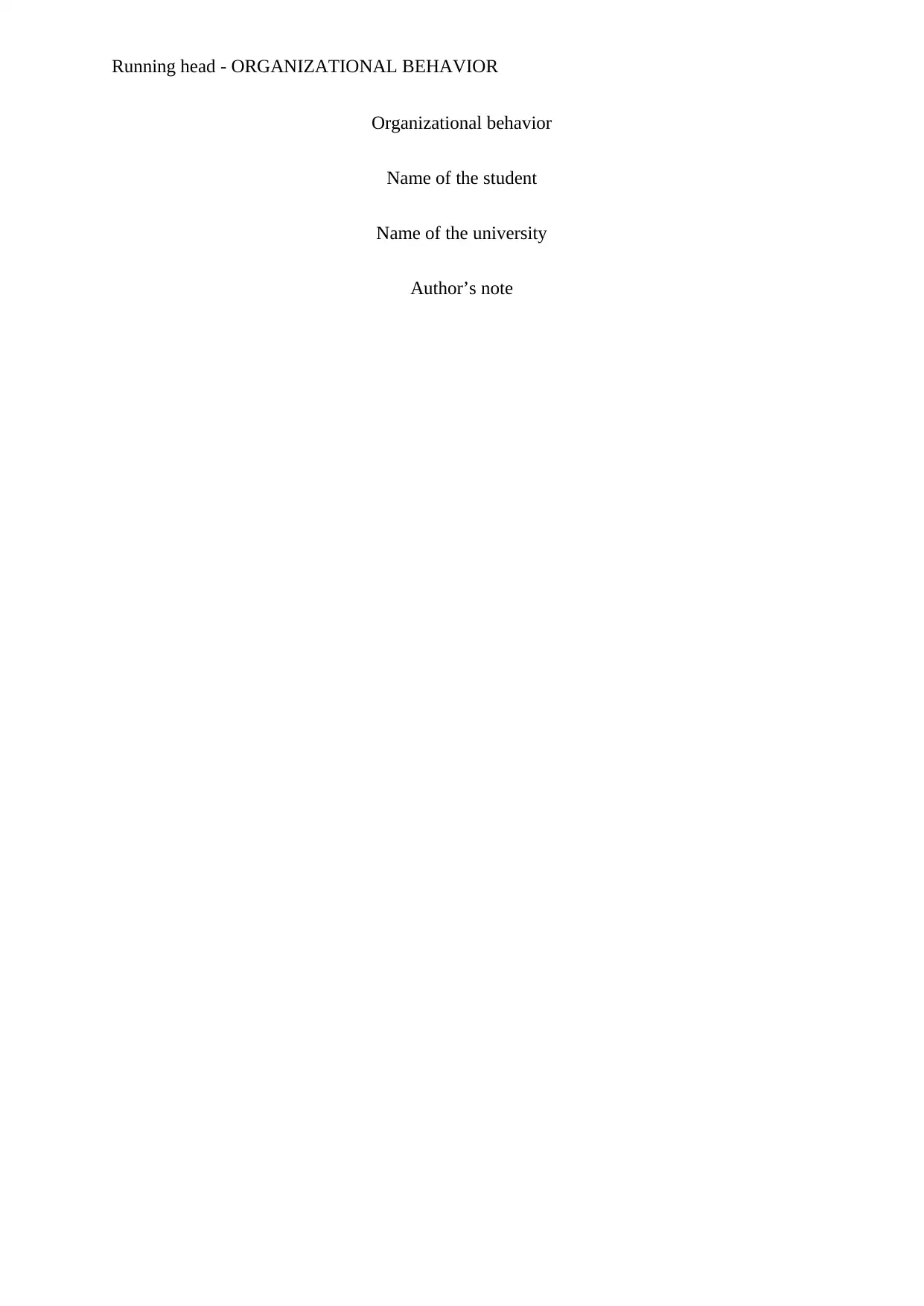
Running head - ORGANIZATIONAL BEHAVIOR
Organizational behavior
Name of the student
Name of the university
Author’s note
Organizational behavior
Name of the student
Name of the university
Author’s note
Paraphrase This Document
Need a fresh take? Get an instant paraphrase of this document with our AI Paraphraser
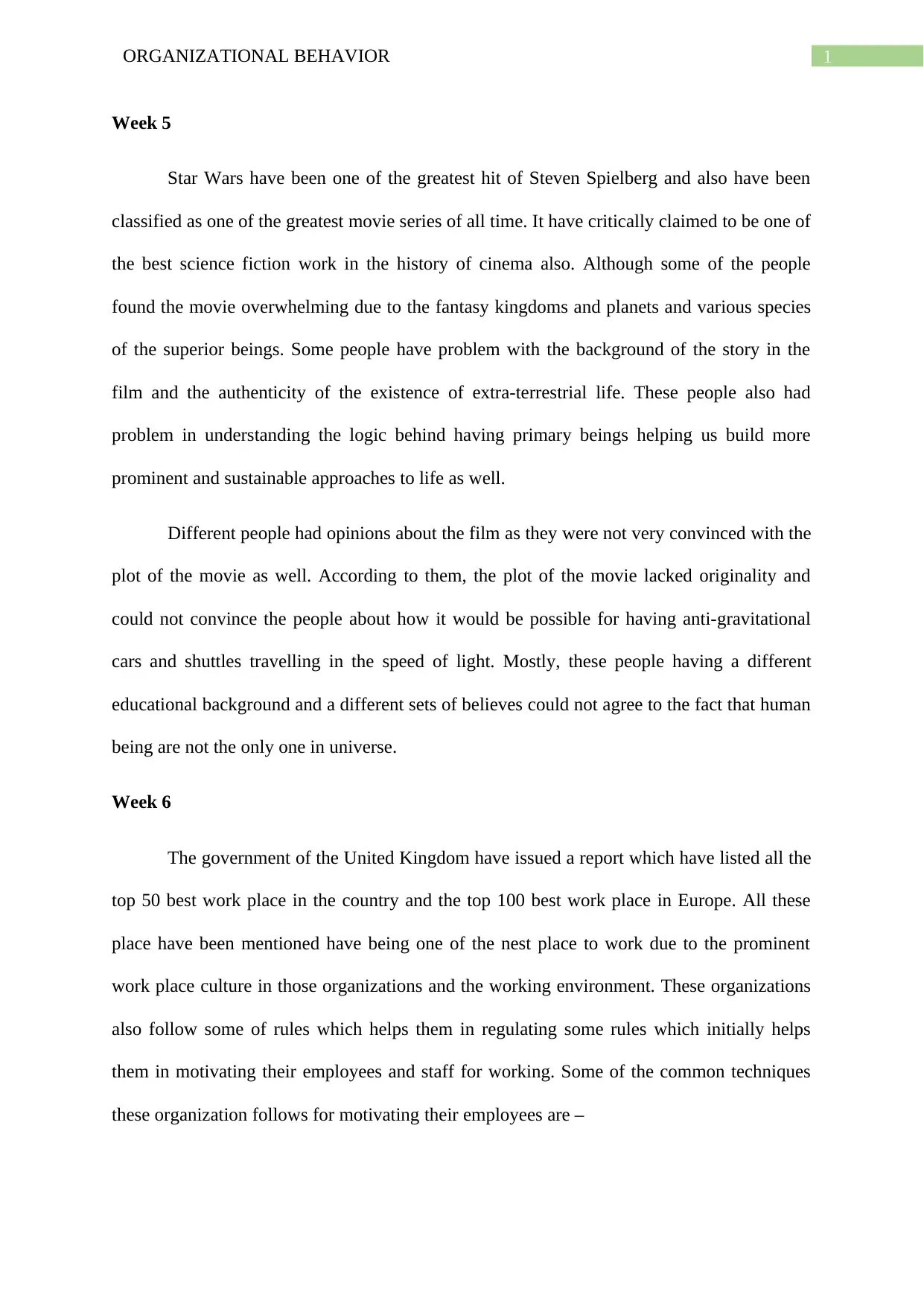
1ORGANIZATIONAL BEHAVIOR
Week 5
Star Wars have been one of the greatest hit of Steven Spielberg and also have been
classified as one of the greatest movie series of all time. It have critically claimed to be one of
the best science fiction work in the history of cinema also. Although some of the people
found the movie overwhelming due to the fantasy kingdoms and planets and various species
of the superior beings. Some people have problem with the background of the story in the
film and the authenticity of the existence of extra-terrestrial life. These people also had
problem in understanding the logic behind having primary beings helping us build more
prominent and sustainable approaches to life as well.
Different people had opinions about the film as they were not very convinced with the
plot of the movie as well. According to them, the plot of the movie lacked originality and
could not convince the people about how it would be possible for having anti-gravitational
cars and shuttles travelling in the speed of light. Mostly, these people having a different
educational background and a different sets of believes could not agree to the fact that human
being are not the only one in universe.
Week 6
The government of the United Kingdom have issued a report which have listed all the
top 50 best work place in the country and the top 100 best work place in Europe. All these
place have been mentioned have being one of the nest place to work due to the prominent
work place culture in those organizations and the working environment. These organizations
also follow some of rules which helps them in regulating some rules which initially helps
them in motivating their employees and staff for working. Some of the common techniques
these organization follows for motivating their employees are –
Week 5
Star Wars have been one of the greatest hit of Steven Spielberg and also have been
classified as one of the greatest movie series of all time. It have critically claimed to be one of
the best science fiction work in the history of cinema also. Although some of the people
found the movie overwhelming due to the fantasy kingdoms and planets and various species
of the superior beings. Some people have problem with the background of the story in the
film and the authenticity of the existence of extra-terrestrial life. These people also had
problem in understanding the logic behind having primary beings helping us build more
prominent and sustainable approaches to life as well.
Different people had opinions about the film as they were not very convinced with the
plot of the movie as well. According to them, the plot of the movie lacked originality and
could not convince the people about how it would be possible for having anti-gravitational
cars and shuttles travelling in the speed of light. Mostly, these people having a different
educational background and a different sets of believes could not agree to the fact that human
being are not the only one in universe.
Week 6
The government of the United Kingdom have issued a report which have listed all the
top 50 best work place in the country and the top 100 best work place in Europe. All these
place have been mentioned have being one of the nest place to work due to the prominent
work place culture in those organizations and the working environment. These organizations
also follow some of rules which helps them in regulating some rules which initially helps
them in motivating their employees and staff for working. Some of the common techniques
these organization follows for motivating their employees are –
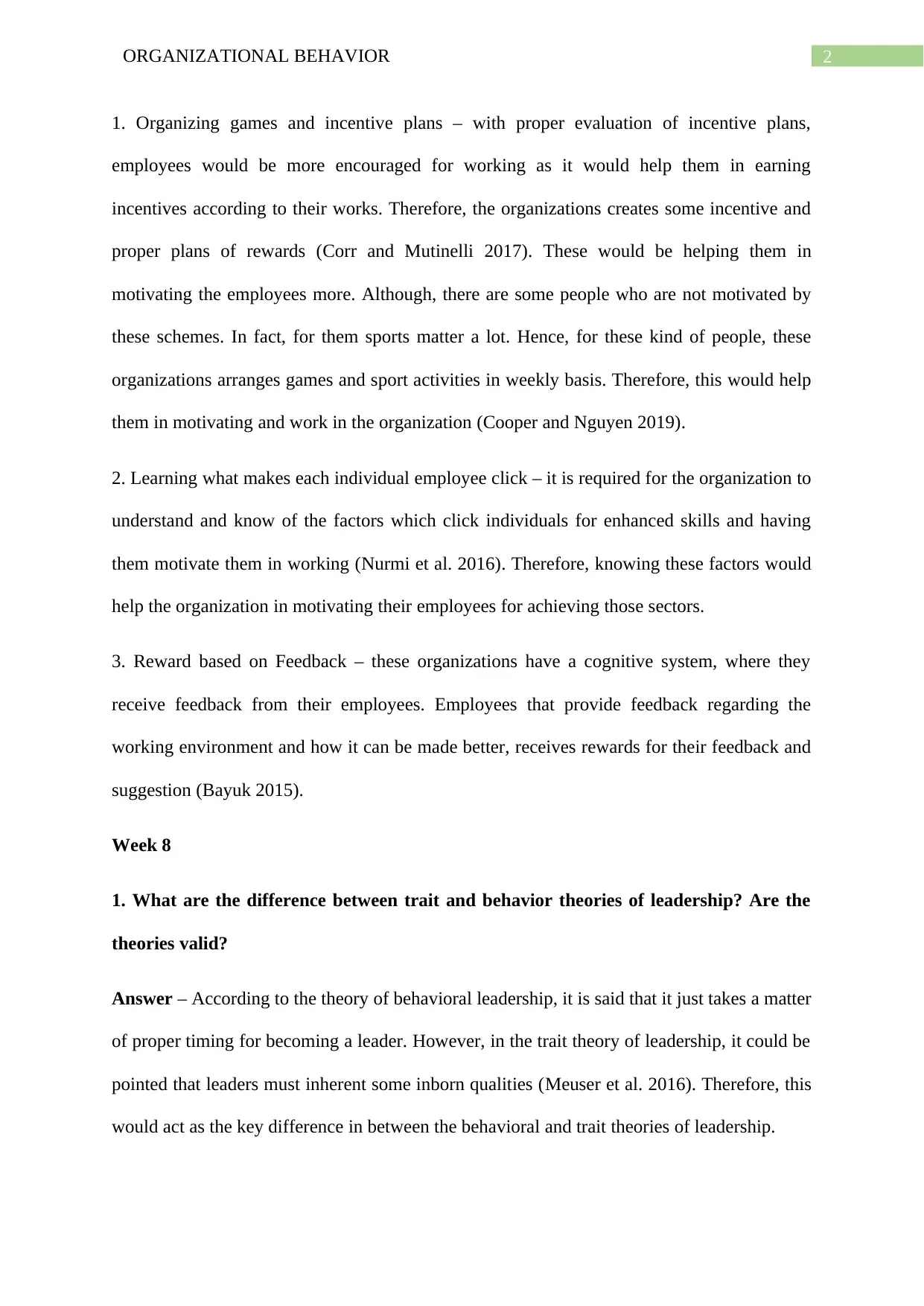
2ORGANIZATIONAL BEHAVIOR
1. Organizing games and incentive plans – with proper evaluation of incentive plans,
employees would be more encouraged for working as it would help them in earning
incentives according to their works. Therefore, the organizations creates some incentive and
proper plans of rewards (Corr and Mutinelli 2017). These would be helping them in
motivating the employees more. Although, there are some people who are not motivated by
these schemes. In fact, for them sports matter a lot. Hence, for these kind of people, these
organizations arranges games and sport activities in weekly basis. Therefore, this would help
them in motivating and work in the organization (Cooper and Nguyen 2019).
2. Learning what makes each individual employee click – it is required for the organization to
understand and know of the factors which click individuals for enhanced skills and having
them motivate them in working (Nurmi et al. 2016). Therefore, knowing these factors would
help the organization in motivating their employees for achieving those sectors.
3. Reward based on Feedback – these organizations have a cognitive system, where they
receive feedback from their employees. Employees that provide feedback regarding the
working environment and how it can be made better, receives rewards for their feedback and
suggestion (Bayuk 2015).
Week 8
1. What are the difference between trait and behavior theories of leadership? Are the
theories valid?
Answer – According to the theory of behavioral leadership, it is said that it just takes a matter
of proper timing for becoming a leader. However, in the trait theory of leadership, it could be
pointed that leaders must inherent some inborn qualities (Meuser et al. 2016). Therefore, this
would act as the key difference in between the behavioral and trait theories of leadership.
1. Organizing games and incentive plans – with proper evaluation of incentive plans,
employees would be more encouraged for working as it would help them in earning
incentives according to their works. Therefore, the organizations creates some incentive and
proper plans of rewards (Corr and Mutinelli 2017). These would be helping them in
motivating the employees more. Although, there are some people who are not motivated by
these schemes. In fact, for them sports matter a lot. Hence, for these kind of people, these
organizations arranges games and sport activities in weekly basis. Therefore, this would help
them in motivating and work in the organization (Cooper and Nguyen 2019).
2. Learning what makes each individual employee click – it is required for the organization to
understand and know of the factors which click individuals for enhanced skills and having
them motivate them in working (Nurmi et al. 2016). Therefore, knowing these factors would
help the organization in motivating their employees for achieving those sectors.
3. Reward based on Feedback – these organizations have a cognitive system, where they
receive feedback from their employees. Employees that provide feedback regarding the
working environment and how it can be made better, receives rewards for their feedback and
suggestion (Bayuk 2015).
Week 8
1. What are the difference between trait and behavior theories of leadership? Are the
theories valid?
Answer – According to the theory of behavioral leadership, it is said that it just takes a matter
of proper timing for becoming a leader. However, in the trait theory of leadership, it could be
pointed that leaders must inherent some inborn qualities (Meuser et al. 2016). Therefore, this
would act as the key difference in between the behavioral and trait theories of leadership.
⊘ This is a preview!⊘
Do you want full access?
Subscribe today to unlock all pages.

Trusted by 1+ million students worldwide
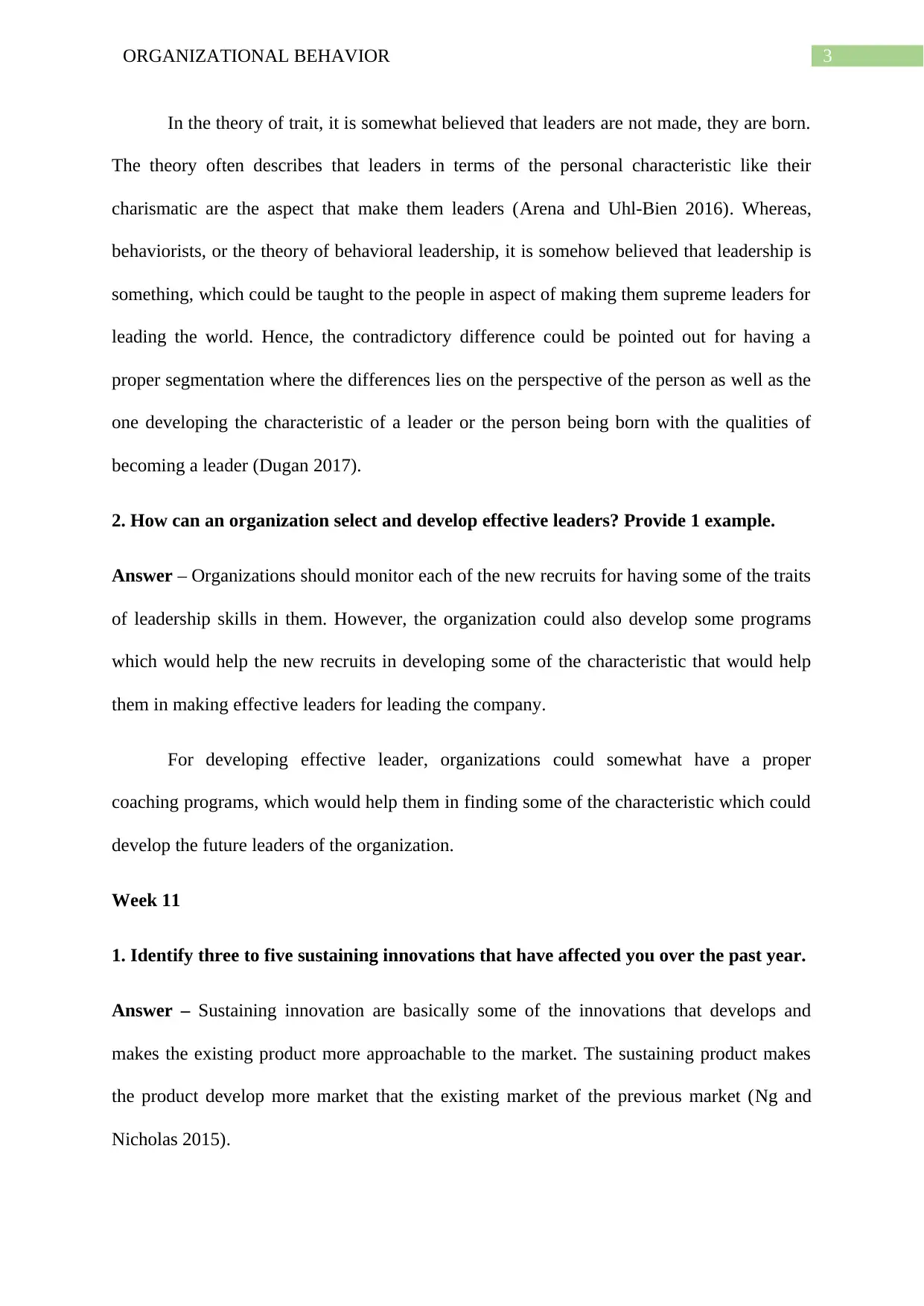
3ORGANIZATIONAL BEHAVIOR
In the theory of trait, it is somewhat believed that leaders are not made, they are born.
The theory often describes that leaders in terms of the personal characteristic like their
charismatic are the aspect that make them leaders (Arena and Uhl-Bien 2016). Whereas,
behaviorists, or the theory of behavioral leadership, it is somehow believed that leadership is
something, which could be taught to the people in aspect of making them supreme leaders for
leading the world. Hence, the contradictory difference could be pointed out for having a
proper segmentation where the differences lies on the perspective of the person as well as the
one developing the characteristic of a leader or the person being born with the qualities of
becoming a leader (Dugan 2017).
2. How can an organization select and develop effective leaders? Provide 1 example.
Answer – Organizations should monitor each of the new recruits for having some of the traits
of leadership skills in them. However, the organization could also develop some programs
which would help the new recruits in developing some of the characteristic that would help
them in making effective leaders for leading the company.
For developing effective leader, organizations could somewhat have a proper
coaching programs, which would help them in finding some of the characteristic which could
develop the future leaders of the organization.
Week 11
1. Identify three to five sustaining innovations that have affected you over the past year.
Answer – Sustaining innovation are basically some of the innovations that develops and
makes the existing product more approachable to the market. The sustaining product makes
the product develop more market that the existing market of the previous market (Ng and
Nicholas 2015).
In the theory of trait, it is somewhat believed that leaders are not made, they are born.
The theory often describes that leaders in terms of the personal characteristic like their
charismatic are the aspect that make them leaders (Arena and Uhl-Bien 2016). Whereas,
behaviorists, or the theory of behavioral leadership, it is somehow believed that leadership is
something, which could be taught to the people in aspect of making them supreme leaders for
leading the world. Hence, the contradictory difference could be pointed out for having a
proper segmentation where the differences lies on the perspective of the person as well as the
one developing the characteristic of a leader or the person being born with the qualities of
becoming a leader (Dugan 2017).
2. How can an organization select and develop effective leaders? Provide 1 example.
Answer – Organizations should monitor each of the new recruits for having some of the traits
of leadership skills in them. However, the organization could also develop some programs
which would help the new recruits in developing some of the characteristic that would help
them in making effective leaders for leading the company.
For developing effective leader, organizations could somewhat have a proper
coaching programs, which would help them in finding some of the characteristic which could
develop the future leaders of the organization.
Week 11
1. Identify three to five sustaining innovations that have affected you over the past year.
Answer – Sustaining innovation are basically some of the innovations that develops and
makes the existing product more approachable to the market. The sustaining product makes
the product develop more market that the existing market of the previous market (Ng and
Nicholas 2015).
Paraphrase This Document
Need a fresh take? Get an instant paraphrase of this document with our AI Paraphraser
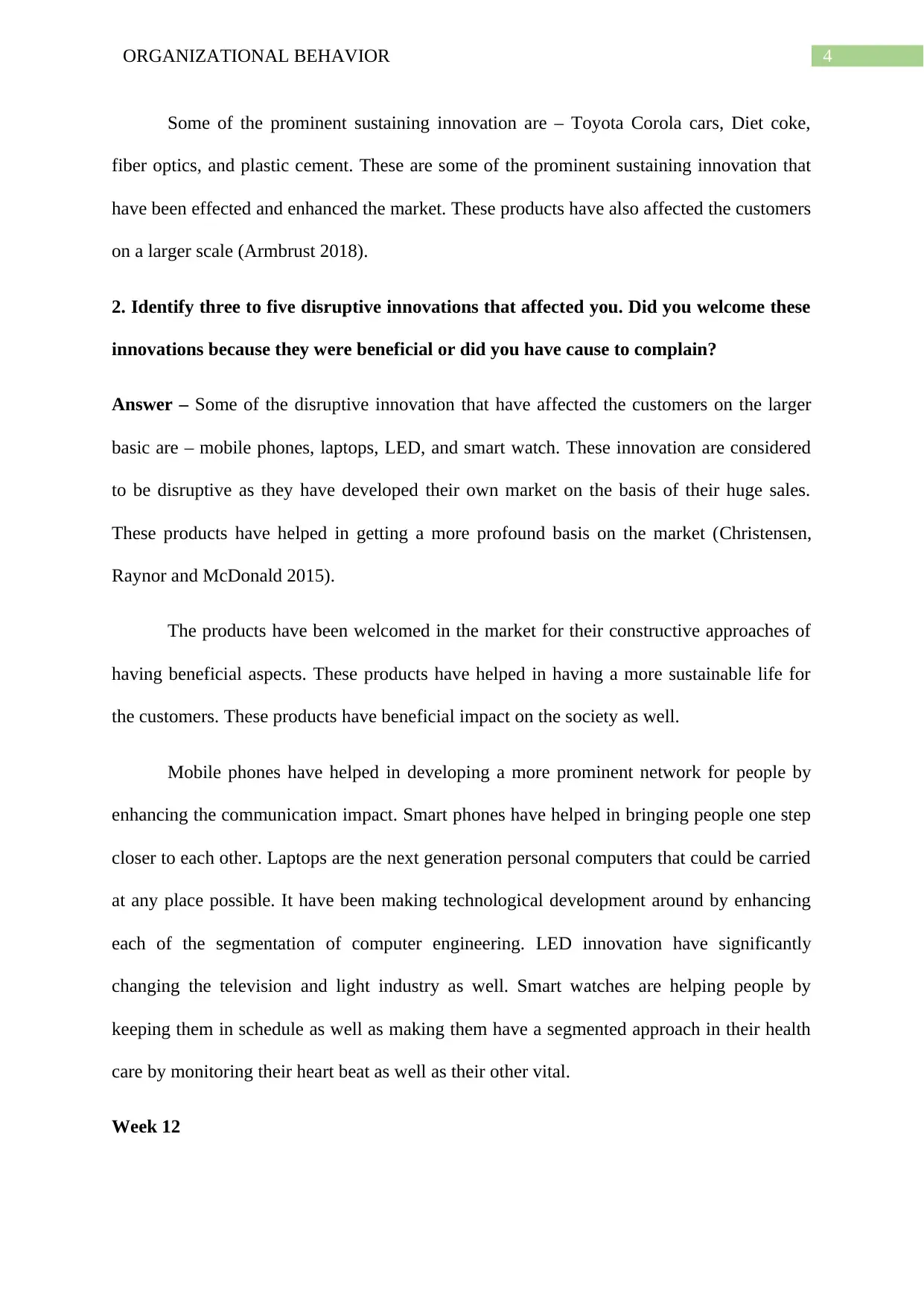
4ORGANIZATIONAL BEHAVIOR
Some of the prominent sustaining innovation are – Toyota Corola cars, Diet coke,
fiber optics, and plastic cement. These are some of the prominent sustaining innovation that
have been effected and enhanced the market. These products have also affected the customers
on a larger scale (Armbrust 2018).
2. Identify three to five disruptive innovations that affected you. Did you welcome these
innovations because they were beneficial or did you have cause to complain?
Answer – Some of the disruptive innovation that have affected the customers on the larger
basic are – mobile phones, laptops, LED, and smart watch. These innovation are considered
to be disruptive as they have developed their own market on the basis of their huge sales.
These products have helped in getting a more profound basis on the market (Christensen,
Raynor and McDonald 2015).
The products have been welcomed in the market for their constructive approaches of
having beneficial aspects. These products have helped in having a more sustainable life for
the customers. These products have beneficial impact on the society as well.
Mobile phones have helped in developing a more prominent network for people by
enhancing the communication impact. Smart phones have helped in bringing people one step
closer to each other. Laptops are the next generation personal computers that could be carried
at any place possible. It have been making technological development around by enhancing
each of the segmentation of computer engineering. LED innovation have significantly
changing the television and light industry as well. Smart watches are helping people by
keeping them in schedule as well as making them have a segmented approach in their health
care by monitoring their heart beat as well as their other vital.
Week 12
Some of the prominent sustaining innovation are – Toyota Corola cars, Diet coke,
fiber optics, and plastic cement. These are some of the prominent sustaining innovation that
have been effected and enhanced the market. These products have also affected the customers
on a larger scale (Armbrust 2018).
2. Identify three to five disruptive innovations that affected you. Did you welcome these
innovations because they were beneficial or did you have cause to complain?
Answer – Some of the disruptive innovation that have affected the customers on the larger
basic are – mobile phones, laptops, LED, and smart watch. These innovation are considered
to be disruptive as they have developed their own market on the basis of their huge sales.
These products have helped in getting a more profound basis on the market (Christensen,
Raynor and McDonald 2015).
The products have been welcomed in the market for their constructive approaches of
having beneficial aspects. These products have helped in having a more sustainable life for
the customers. These products have beneficial impact on the society as well.
Mobile phones have helped in developing a more prominent network for people by
enhancing the communication impact. Smart phones have helped in bringing people one step
closer to each other. Laptops are the next generation personal computers that could be carried
at any place possible. It have been making technological development around by enhancing
each of the segmentation of computer engineering. LED innovation have significantly
changing the television and light industry as well. Smart watches are helping people by
keeping them in schedule as well as making them have a segmented approach in their health
care by monitoring their heart beat as well as their other vital.
Week 12
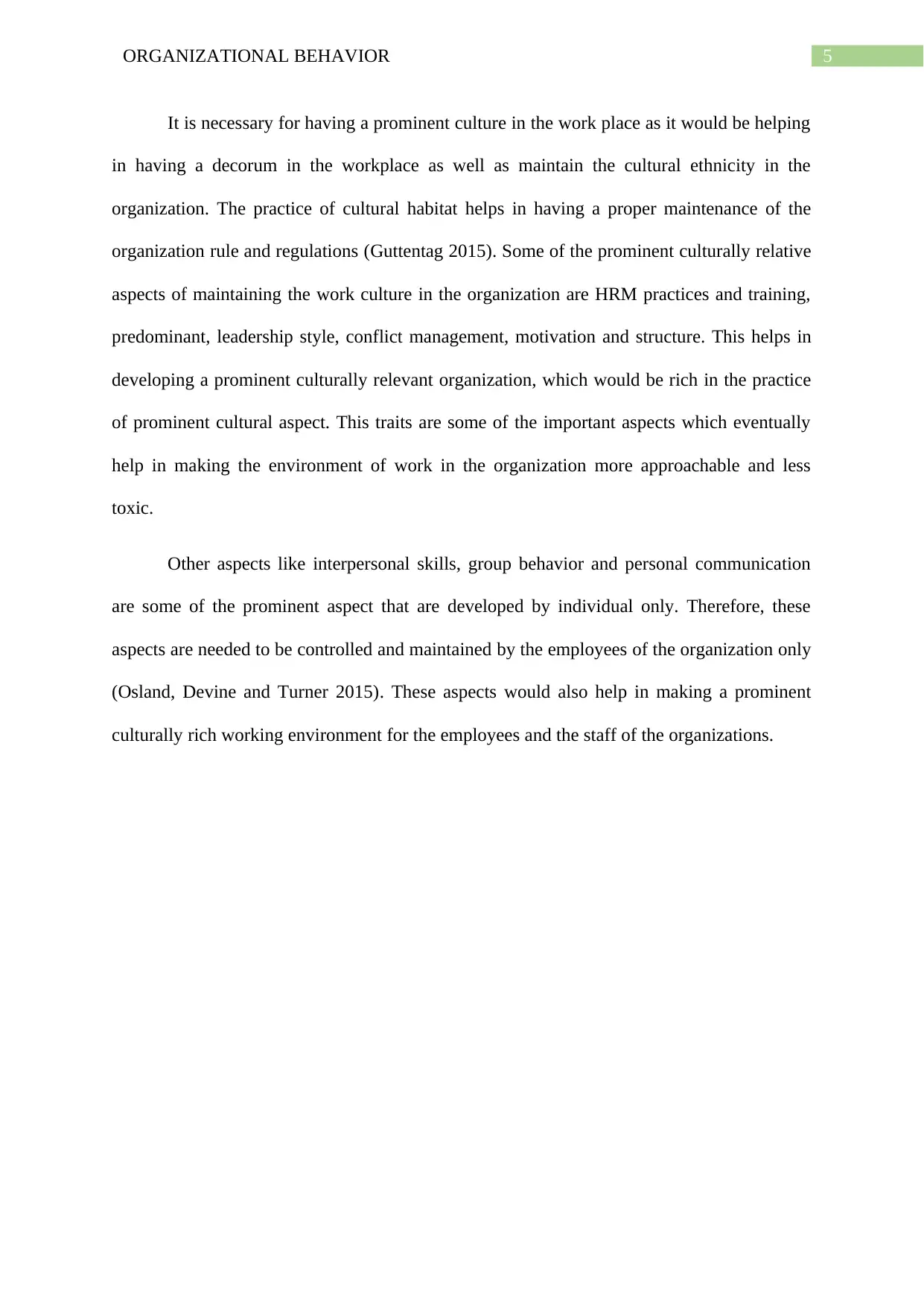
5ORGANIZATIONAL BEHAVIOR
It is necessary for having a prominent culture in the work place as it would be helping
in having a decorum in the workplace as well as maintain the cultural ethnicity in the
organization. The practice of cultural habitat helps in having a proper maintenance of the
organization rule and regulations (Guttentag 2015). Some of the prominent culturally relative
aspects of maintaining the work culture in the organization are HRM practices and training,
predominant, leadership style, conflict management, motivation and structure. This helps in
developing a prominent culturally relevant organization, which would be rich in the practice
of prominent cultural aspect. This traits are some of the important aspects which eventually
help in making the environment of work in the organization more approachable and less
toxic.
Other aspects like interpersonal skills, group behavior and personal communication
are some of the prominent aspect that are developed by individual only. Therefore, these
aspects are needed to be controlled and maintained by the employees of the organization only
(Osland, Devine and Turner 2015). These aspects would also help in making a prominent
culturally rich working environment for the employees and the staff of the organizations.
It is necessary for having a prominent culture in the work place as it would be helping
in having a decorum in the workplace as well as maintain the cultural ethnicity in the
organization. The practice of cultural habitat helps in having a proper maintenance of the
organization rule and regulations (Guttentag 2015). Some of the prominent culturally relative
aspects of maintaining the work culture in the organization are HRM practices and training,
predominant, leadership style, conflict management, motivation and structure. This helps in
developing a prominent culturally relevant organization, which would be rich in the practice
of prominent cultural aspect. This traits are some of the important aspects which eventually
help in making the environment of work in the organization more approachable and less
toxic.
Other aspects like interpersonal skills, group behavior and personal communication
are some of the prominent aspect that are developed by individual only. Therefore, these
aspects are needed to be controlled and maintained by the employees of the organization only
(Osland, Devine and Turner 2015). These aspects would also help in making a prominent
culturally rich working environment for the employees and the staff of the organizations.
⊘ This is a preview!⊘
Do you want full access?
Subscribe today to unlock all pages.

Trusted by 1+ million students worldwide
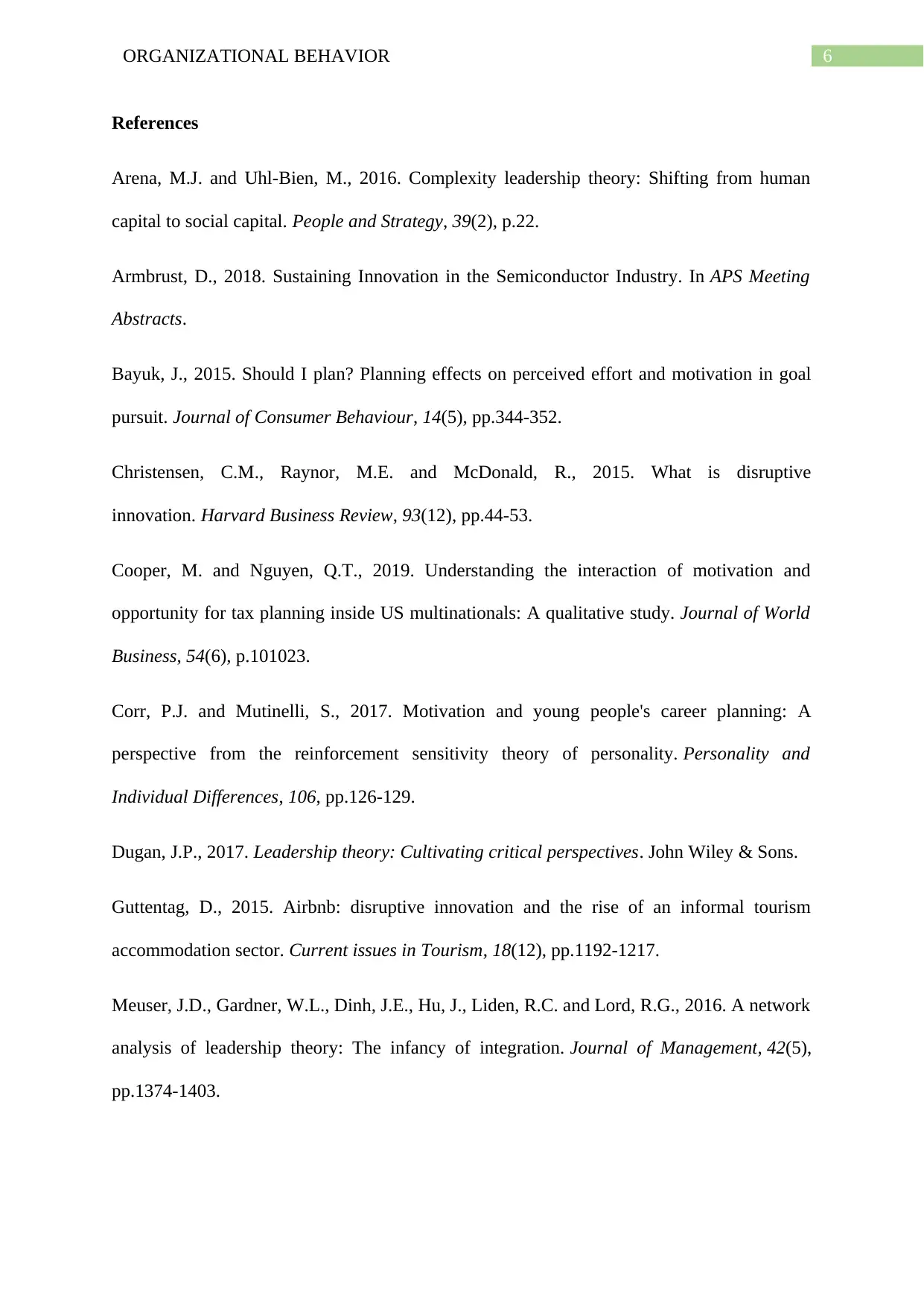
6ORGANIZATIONAL BEHAVIOR
References
Arena, M.J. and Uhl-Bien, M., 2016. Complexity leadership theory: Shifting from human
capital to social capital. People and Strategy, 39(2), p.22.
Armbrust, D., 2018. Sustaining Innovation in the Semiconductor Industry. In APS Meeting
Abstracts.
Bayuk, J., 2015. Should I plan? Planning effects on perceived effort and motivation in goal
pursuit. Journal of Consumer Behaviour, 14(5), pp.344-352.
Christensen, C.M., Raynor, M.E. and McDonald, R., 2015. What is disruptive
innovation. Harvard Business Review, 93(12), pp.44-53.
Cooper, M. and Nguyen, Q.T., 2019. Understanding the interaction of motivation and
opportunity for tax planning inside US multinationals: A qualitative study. Journal of World
Business, 54(6), p.101023.
Corr, P.J. and Mutinelli, S., 2017. Motivation and young people's career planning: A
perspective from the reinforcement sensitivity theory of personality. Personality and
Individual Differences, 106, pp.126-129.
Dugan, J.P., 2017. Leadership theory: Cultivating critical perspectives. John Wiley & Sons.
Guttentag, D., 2015. Airbnb: disruptive innovation and the rise of an informal tourism
accommodation sector. Current issues in Tourism, 18(12), pp.1192-1217.
Meuser, J.D., Gardner, W.L., Dinh, J.E., Hu, J., Liden, R.C. and Lord, R.G., 2016. A network
analysis of leadership theory: The infancy of integration. Journal of Management, 42(5),
pp.1374-1403.
References
Arena, M.J. and Uhl-Bien, M., 2016. Complexity leadership theory: Shifting from human
capital to social capital. People and Strategy, 39(2), p.22.
Armbrust, D., 2018. Sustaining Innovation in the Semiconductor Industry. In APS Meeting
Abstracts.
Bayuk, J., 2015. Should I plan? Planning effects on perceived effort and motivation in goal
pursuit. Journal of Consumer Behaviour, 14(5), pp.344-352.
Christensen, C.M., Raynor, M.E. and McDonald, R., 2015. What is disruptive
innovation. Harvard Business Review, 93(12), pp.44-53.
Cooper, M. and Nguyen, Q.T., 2019. Understanding the interaction of motivation and
opportunity for tax planning inside US multinationals: A qualitative study. Journal of World
Business, 54(6), p.101023.
Corr, P.J. and Mutinelli, S., 2017. Motivation and young people's career planning: A
perspective from the reinforcement sensitivity theory of personality. Personality and
Individual Differences, 106, pp.126-129.
Dugan, J.P., 2017. Leadership theory: Cultivating critical perspectives. John Wiley & Sons.
Guttentag, D., 2015. Airbnb: disruptive innovation and the rise of an informal tourism
accommodation sector. Current issues in Tourism, 18(12), pp.1192-1217.
Meuser, J.D., Gardner, W.L., Dinh, J.E., Hu, J., Liden, R.C. and Lord, R.G., 2016. A network
analysis of leadership theory: The infancy of integration. Journal of Management, 42(5),
pp.1374-1403.
Paraphrase This Document
Need a fresh take? Get an instant paraphrase of this document with our AI Paraphraser
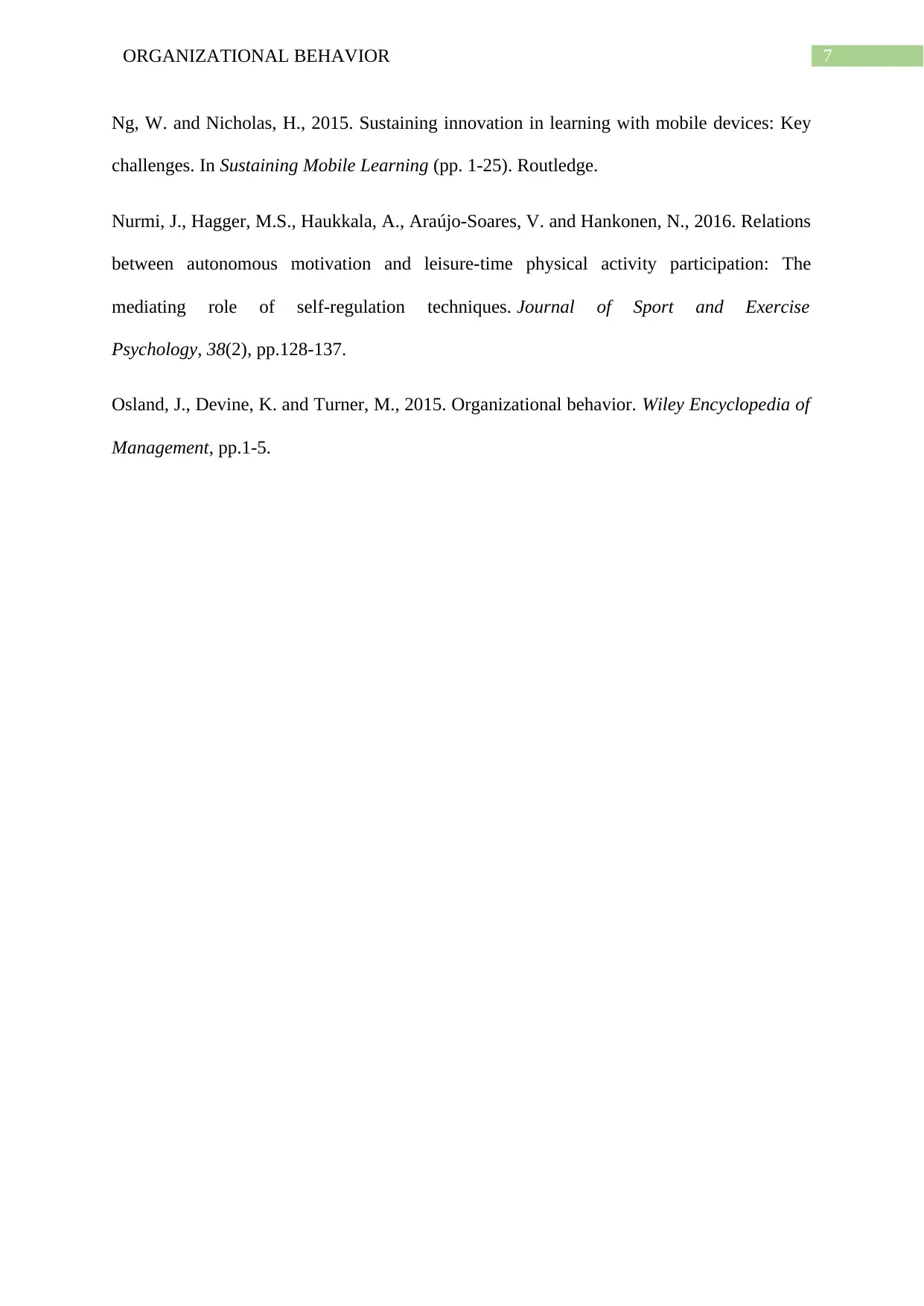
7ORGANIZATIONAL BEHAVIOR
Ng, W. and Nicholas, H., 2015. Sustaining innovation in learning with mobile devices: Key
challenges. In Sustaining Mobile Learning (pp. 1-25). Routledge.
Nurmi, J., Hagger, M.S., Haukkala, A., Araújo-Soares, V. and Hankonen, N., 2016. Relations
between autonomous motivation and leisure-time physical activity participation: The
mediating role of self-regulation techniques. Journal of Sport and Exercise
Psychology, 38(2), pp.128-137.
Osland, J., Devine, K. and Turner, M., 2015. Organizational behavior. Wiley Encyclopedia of
Management, pp.1-5.
Ng, W. and Nicholas, H., 2015. Sustaining innovation in learning with mobile devices: Key
challenges. In Sustaining Mobile Learning (pp. 1-25). Routledge.
Nurmi, J., Hagger, M.S., Haukkala, A., Araújo-Soares, V. and Hankonen, N., 2016. Relations
between autonomous motivation and leisure-time physical activity participation: The
mediating role of self-regulation techniques. Journal of Sport and Exercise
Psychology, 38(2), pp.128-137.
Osland, J., Devine, K. and Turner, M., 2015. Organizational behavior. Wiley Encyclopedia of
Management, pp.1-5.
1 out of 8
Related Documents
Your All-in-One AI-Powered Toolkit for Academic Success.
+13062052269
info@desklib.com
Available 24*7 on WhatsApp / Email
![[object Object]](/_next/static/media/star-bottom.7253800d.svg)
Unlock your academic potential
Copyright © 2020–2025 A2Z Services. All Rights Reserved. Developed and managed by ZUCOL.




